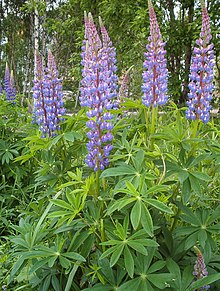Lupinus polyphyllus
| Lupinus polyphyllus | |
|---|---|
 |
|
| Scientific classification | |
| Kingdom: | Plantae |
| (unranked): | Angiosperms |
| (unranked): | Eudicots |
| (unranked): | Rosids |
| Order: | Fabales |
| Family: | Fabaceae |
| Subfamily: | Faboideae |
| Tribe: | Genisteae |
| Subtribe: | Lupininae |
| Genus: | Lupinus |
| Subgenus: | Platycarpos |
| Species: | L. polyphyllus |
| Binomial name | |
|
Lupinus polyphyllus Lindl. |
|
Lupinus polyphyllus (large-leaved lupine, big-leaved lupine, many-leaved lupine or, primarily in cultivation, garden lupin) is a species of lupine (lupin) native to western North America from southern Alaska and British Columbia east to Quebec, and western Wyoming, and south to Utah and California. It commonly grows along streams and creeks, preferring moist habitats.
It is a perennial herbaceous plant with stout stems growing to 1.5 metres (4 ft 11 in) tall. The leaves are palmately compound with (5-) 9-17 leaflets 3–15 centimetres (1.2–5.9 in) long. The flowers are produced on a tall spike, each flower 1–1.5 centimetres (0.39–0.59 in) long, most commonly blue to purple in wild plants. The flowers are mostly visited by bumblebees. The polyphyllus variety in particular make up a great number of the hybrids which are generally grown as garden lupines, they can vary dramatically in colours. The majority of lupines do not thrive in rich heavy soils, and often only live for a matter of years if grown in such places, crown contact with manure or rich organic matter encourages rotting.
There are five varieties:
The herbaceous lupine, Lupinus polyphyllus, arrived in Britain from North America in the 1820s, brought over by David Douglas. Almost a century later, George Russell [1][2], a horticulturist from York, UK, started to breed the (later famous) Russell hybrids (Lupinus X russellii hort). Lupinus polphyllus originally were of basic colours and had large gaps in the flowering spike. Without the use of modern-day plant breeding techniques, Russell took to ruthlessly pulling out any plants which he deemed to be unacceptable in growth or display. He spent two decades single-mindedly trying to breed the perfect lupine, crossing L. polyphyllus with L. arboreus, L. sulphureus and one or more annual species (maybe L. nootkatensis).
...
Wikipedia
